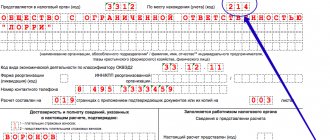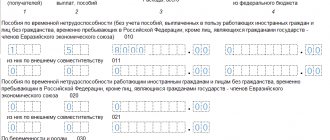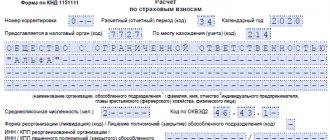You need to report on insurance premiums in 2021 to the Federal Tax Service, and not to extra-budgetary funds. Tax authorities have developed a new calculation form that replaces the previous 4-FSS and RSV-1 calculations; it must be applied starting with reporting for the 1st quarter of 2021. The form and instructions for filling out the calculation were approved by Order of the Federal Tax Service dated October 10, 2016 No. ММВ-7-11/551. In addition, new BCCs are now used to pay insurance premiums.
Read more about the new form, as well as the procedure for filling it out with an example, in this article.
The procedure for submitting the calculation of insurance premiums in 2021
Organizations and individual entrepreneurs with employees must submit a new single calculation to the Federal Tax Service on a quarterly basis. The last day for submitting calculations is the 30th day of the month following the reporting period (clause 7 of Article 431 of the Tax Code of the Russian Federation). The first report on the new form must be submitted no later than May 2, 2021, due to the postponement of dates due to the May holidays.
With an average number of more than 25 people, a single calculation must be submitted only in electronic form; others can submit it on paper. Please note that the due date for premium calculations from 2021 onwards is now the same for all policyholders, regardless of how they submit the calculation.
Important: the calculation is considered not submitted if the total pension contributions for each employee do not coincide with the total amount of Pension Fund contributions. After receiving notification of this from the Federal Tax Service, the policyholder has 5 days to eliminate the error, otherwise a fine cannot be avoided.
What are the names of the reports and documents that are still submitted to the funds?
For a number of types of reporting, the obligation to submit it to the funds remains:
1. The following are submitted to the Pension Fund:
- form SZV-M (on the availability of employees), submitted there monthly on the 15th day of the month following the reporting month;
- information about length of service and payment of additional insurance premiums, which must be submitted once over the past year, before March 1 of the next year.
2. The 4-FSS report is submitted to the FSS, reducing its form to the section devoted to contributions for injuries in the month following the next quarter:
- until the 20th, if submitted on paper;
- until the 25th, if delivery is done electronically.
Read about the preparation of the updated 4-FSS in the material “How is the calculation made using the 4-FSS form?”
The Social Insurance Fund will continue to reimburse funds spent by the payer of contributions on insurance payments. To receive such a payment, you will need to provide the fund (order of the Ministry of Health and Social Development of Russia dated December 4, 2009 No. 951n):
- statement;
- calculation of contributions to OSS for disability and maternity, if funds are required to be returned for the period before 01/01/2017;
- a statement of payment of a certain form, if the appeal relates to funds spent after 01/01/2017;
- copies of documents confirming expenses incurred.
For more information about preparing documents for reimbursement of expenses, read the article “Application for reimbursement for sick leave in the Social Insurance Fund 2016–2017.”
How to fill out the Calculation of insurance premiums in 2021
The calculation consists of a title page and three sections. In turn, sections 1 and 2 include applications: in section 1 there are 10 of them, in section 2 there is only one application. All policyholders are required to submit the following parts of the Calculation:
- Title page,
- Section 1, containing summary data on insurance premiums payable to the budget,
- Subsection 1.1 of Appendix No. 1 of Section 1 – calculation of pension contributions,
- Subsection 1.2 of Appendix No. 1 of Section 1 – calculation of compulsory medical insurance contributions,
- Appendix No. 2 of Section 1 – calculation of social insurance contributions in case of temporary disability and in connection with maternity,
- Section 3 – personalized information about insured persons.
The remaining subsections and annexes are presented if there is data to fill them out.
The calculation is completed in rubles and kopecks. In unfilled cells, dashes are added. All words in the Calculation lines are written in capital letters. The detailed line-by-line procedure for filling out the Calculation was approved by order of the Federal Tax Service of the Russian Federation dated October 10, 2016 No. ММВ-7-11/551.
Let's look at how to calculate insurance premiums in 2021 using the following example.
In the 1st quarter of 2021, Alpha LLC accrued insurance premiums from payments to 1 employee, who is also the manager. The organization works on the simplified tax system and applies the basic tariff of insurance premiums.
Contributory payments to Mikhailov I.P. amounted to 30,000 rubles monthly. In January-March, insurance premiums were charged for each month:
Pension Fund (22%) - 6600.00 rubles each, compulsory medical insurance (5.1%) - 1530.00 rubles each, social insurance (2.9%) - 870.00 rubles each.
The total amount of payments to Alpha LLC for the 1st quarter: 90,000 rubles.
The total amount of contributions of Alpha LLC for the 1st quarter: Pension Fund (22%) - 19,800.00 rubles, compulsory medical insurance (5.1%) - 4590.00 rubles, social insurance (2.9%) - 2610.00 rubles.
It will be more convenient to fill out the sections for calculating insurance premiums in 2021, the example of which we are considering, in the following sequence:
- First, fill in the personalized information in section 3 . This section is completed for all insured persons and includes information for the last 3 months. In our case, the information is filled in for one employee, but if there are more insured persons, then the amount of information in the Calculation must correspond to their number.
- The next step is to fill out subsection 1.1 of appendix 1 of section 1 on pension contributions: we summarize and transfer here the accounting data from section 3. Remember that all indicators of personalized information in total must coincide with the indicators of subsection 1.1. Our example is simplified and there is only one employee, so we simply transfer his indicators from section 3.
- Next, fill out subsection 1.2 of Appendix 1 of Section 1 on contributions to compulsory medical insurance. Indicators of insurance premiums for health insurance are reflected only in this section of the Calculation.
- Social insurance premiums are calculated in Appendix 2 of Section 1 . If there were social insurance expenses (sick leave, benefits) during the billing period, then this should be reflected in Appendix 3 to Section 1, which means line 070 of Appendix 2 of Section 1 should be filled in. In our example, there were no such expenses, so Appendix 3 is not fill it out.
- Having filled out the sections for each type of contribution, we fill out the summary section 1 . The amount of insurance premiums payable to the budget is indicated here. Please note that the BCC indicated on lines 020, 040, 060, 080 and 100 have not yet been approved for 2021, so in our example the codes for 2021 are indicated, in which the first 3 digits are replaced by 182, which means payment to the Federal Tax Service.
- In conclusion, we number all completed Calculation sheets and indicate their number in a special line on the Title Page. Under each section we will put the signature of the head and the date.
What new provisions have been introduced regarding contributions from 1 January 2021?
Changes in insurance premiums that came into force on January 1, 2017, at first glance, are small:
1. Traditionally, the income limits have been increased (Resolution of the Government of the Russian Federation dated November 29, 2016 No. 1255), which are the limits for calculating contributions to compulsory health insurance and social insurance, to the following values:
- 876,000 rub. according to the OPS, upon reaching which the value of the tariff used for calculation changes;
- 755,000 rub. according to OSS, the achievement of which means the cessation of accrual of contributions.
2. Contributions previously paid to the Pension Fund, Compulsory Medical Insurance Fund, Social Insurance Fund (in terms of disability and maternity), began to be subject to the provisions of the Tax Code of the Russian Federation, which was supplemented with a new chapter dedicated to these contributions. This chapter is based on the text of the no longer valid law “On Insurance Contributions...” dated July 24, 2009 No. 212-FZ. This process did not lead to fundamental changes in the rules for determining the tax base, the size of tariffs and the deadlines for paying contributions. However, a number of adjustments have been made to them.
The inclusion of contributions in the Tax Code of the Russian Federation equated them to tax payments and automatically transferred them under the control of the tax authorities. The statement of this fact was reflected in the addition of the general provisions of the Tax Code of the Russian Federation, contained in Part 1 of the Code, with references to insurance premiums.
Corresponding adjustments in connection with the change of the premium administrator were required by the texts of most regulations that mention insurance premiums, and, in particular, by the laws:
- “On individual (personalized) accounting...” dated 04/01/1996 No. 27-FZ;
- “On compulsory social insurance...” dated December 29, 2006 No. 255-FZ;
- “On compulsory social insurance...” dated July 24, 1998 No. 125-FZ.
At the same time, the law of July 24, 1998 No. 125-FZ, dedicated to injury insurance, remained in force and retained the right of the FSS to control “accident” contributions. There have been no changes to the rules for their calculation and payment.
About payments for separate divisions
Changes in reporting regarding calculations of insurance premiums appeared in January 2017 and in relation to separate divisions. Now all OPs, regardless of whether they have a separate account or balance sheet, are required to generate reports and make payments at the place of registration (clause 11 of Article 431 of the Tax Code of the Russian Federation).
The Tax Code (clause 7, clause 3, 4, article 23) also obliges “isolated organizations” from now on to notify the Federal Tax Service that the OP must pay contributions within a month from the date of this decision. This also applies to Russian branches and representative offices.
This rule also applies to the largest taxpayers, which, as a rule, are public joint-stock companies (PJSC). The Tax Code also requires them to pay insurance premiums and make payments for them not only at the place of registration of the head office, but also at the location of the “isolations”.
In contrast to tax reporting: it, on the basis of clause 3 of Art. 80 of the Tax Code of the Russian Federation, are handed over exclusively at the place of registration of the company itself.
The procedure for clarifying data on individuals
Data about employees changes from time to time: people get married and divorced, change their last names, families become large, etc. And errors and inaccuracies in previous versions of documents are also sometimes discovered and require correction.
Clause 6 of Article 81 of the Tax Code of the Russian Federation lists the grounds for making changes to the calculation of this purpose:
- lack of required information or its incompleteness;
- errors that distort the calculation of the final amount of insurance premiums.
Clarifications to section 3 “Personalized information about insured persons” of this calculation should be made only about those persons for whom changes or additions have appeared. This data is entered, giving the serial number of the individual used in the initial calculation. Often, to accurately identify a person, the document also indicates his personnel number, recorded in the personnel service of the enterprise or organization where he works.
Composition of the Calculation...
The calculation consists of a title page and three sections.
At a glance, we note that an innovation is the appearance in the reporting of a sheet that is intended to be filled out by individuals who are not individual entrepreneurs (IP).
… Section 1
Section 1 of the Calculation is filled out by contribution payers who make payments to individuals. It contains summary data on the amounts of contributions payable (for each type of contribution).
Individual applications reflect
- calculations of the amounts of contributions for compulsory pension, medical and social insurance (number of insured persons, amount of accrued payments, amount of payments not subject to contributions, contribution base). In a separate subsection, it is necessary to reflect data on contributions for additional social security for aircraft flight crew members and coal industry workers. Before the Order came into force, the report RV-3 of the Pension Fund of Russia, approved, was used for such information. Resolution of the Board of the Pension Fund of the Russian Federation dated July 20, 2015 No. 269p;
- expenses for compulsory social insurance (benefits);
- payments financed from the federal budget (in particular, payment for additional days off provided to care for disabled children). Before the new Calculation form came into force, this information was reflected in tables 2 and 5 of form 4-FSS, approved. by order of the FSS of the Russian Federation dated February 26, 2015 No. 59.
Also, individual applications of the Calculation reflect information on compliance with the conditions for applying reduced contribution rates.
Applications with such calculations must be filled out by payers who calculate contributions at reduced rates for one reason or another.
The reporting form stipulates that the right to reduced tariffs must be confirmed by:
- IT organizations;
- insurers on the simplified tax system whose main activity is one of those listed in subparagraph 5 of paragraph 1 of Article 427 of the Tax Code of the Russian Federation;
- non-profit organizations on the simplified tax system.
Before the Order came into force, the listed “preferential” categories of policyholders filled out subsections 3.1, 3.2, 3.3 in the RSV-1 Pension Fund reports (approved by Resolution of the Board of the Pension Fund of the Russian Federation dated January 16, 2014 No. 2p) 3.1, 3.2, 3.3, respectively.
Also, the right to reduced tariffs must be confirmed by individual entrepreneurs using the patent tax system (PTS).
Previously, such entrepreneurs confirmed their right to reduced tariffs by filling out table 4.3 in form 4-FSS.
For other insurers (listed in Article 427 of the Tax Code of the Russian Federation) who are entitled to reduced premium rates, the new unified calculation form does not provide special sections.
As in the calculation using Form 4-FSS, the new calculation has a separate application for reflecting information about temporarily staying foreign workers (except for highly qualified specialists (HQS) and citizens of the EAEU member states). It differs in that it will need to additionally reflect information about the amount of payments in favor of such citizens.
...Section 2
Section 2 of the Calculation must be completed by the heads of peasant farms (peasant farms). Before the Order came into force, heads of peasant farms reported to the Pension Fund of the Russian Federation, submitting calculations in the RSV-2 form of the Pension Fund of the Russian Federation, approved. Resolution of the Board of the Pension Fund of the Russian Federation dated September 17, 2015 No. 347p.
Some nuances of filling out the RSV
Reflection of expenses not subject to contributions
Is it necessary to include expenses that are not subject to insurance premiums in the calculation? The answer depends on whether the payment is subject to contributions or not. If not, then there is no need to reflect it. If the payment is subject to accrual , but according to Article 422 of the Tax Code of the Russian Federation is exempt from contributions, then it should be reflected in the form.
In this case, the calculation indicates the taxable base - this is the amount of accrued payments, which is included in the taxable object, reduced by the amounts exempt from contributions.
Example. Let's consider two payments: payment for property leased from an individual, and child care allowance for up to one and a half years. Both payments are free of insurance premiums. In this case, the rent will not be reflected in the DAM, and the allowance must be included in the calculation.
Explanation . Rent is not subject to the calculation of insurance premiums, therefore it is not included in the DAM. But with child care benefits everything is different. In general, payments in favor of individuals subject to compulsory social insurance are recognized as subject to insurance premiums on the basis of paragraph 1 of Article 420 of the Tax Code of the Russian Federation. Therefore, despite the fact that Article 422 of the Code exempts child care benefits from insurance contributions, such payments are included in the DAM.
How to fill out the calculation when combining simplified taxation system and UTII
This situation was explained by the Federal Tax Service (letter dated December 28, 2017 No. GD-4-11/ [email protected] ). The rules are:
- Appendix 1 to section 1 . Line 001 indicates the tariff code used by the fee payer. You can find the code in the above-mentioned Procedure for filling out the RSV (Appendix No. 5).
- Section 3 . Columns 200 indicate the category code of the insured person (Appendix No. 8 to the Procedure).
These indicators must match.
Which payer rate code should I choose? Companies that pay contributions at the general rate and combine “imputed” and “simplified” must indicate any of the codes “01”, “02”, “03” . Appendix 1 to Section 1 of the calculation is filled out by them in one copy.
Rules for filling out Section 3
The fields “Last name”, “First name”, “Citizenship (country code)” must be filled in. In this case, certain rules are established (Table 3).
Table 3. Rules for filling out Section 3 of the DAM form
| Field | Rules | Unacceptable |
| Surname |
| presence of the symbol "." (dot), "-" (hyphen), "'" (apostrophe), " " (space) as first, last, or only character |
| First name, patronymic (if available) |
| |
| TIN in the Russian Federation |
| |
| SNILS | must consist of 11 digits in the format XXX-XXX-XXX-XX or XXX-XXX-XXX XX, where X takes numeric values from 0 to 9 | |
| Series and document number (for citizens of the Russian Federation) | should look like “XX XX XXXXXX”, where X takes numeric values from 0 to 9 (series separated by space) | |
| Date of Birth |
| |










